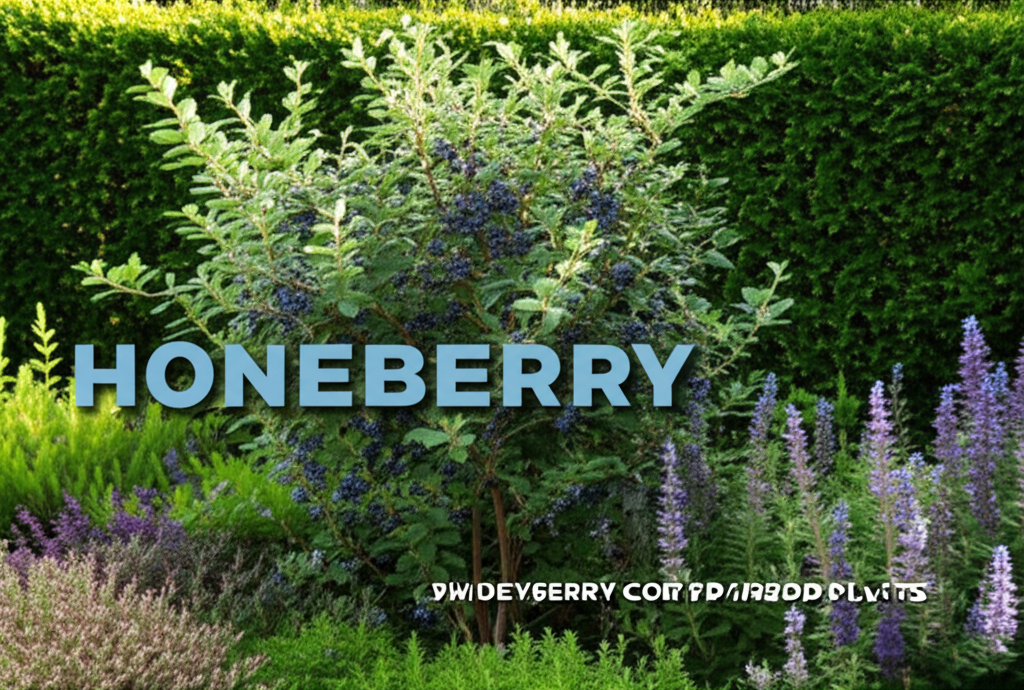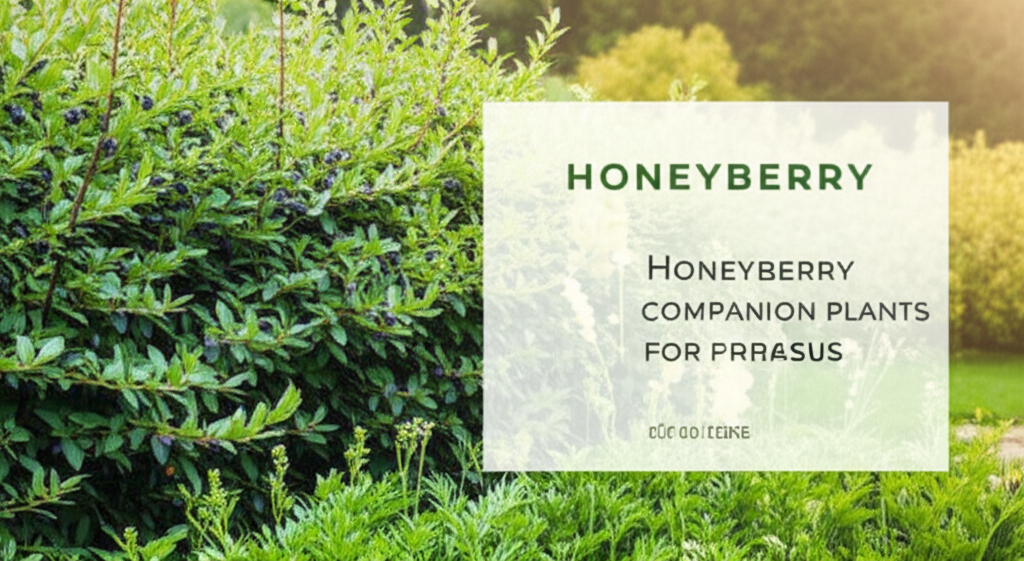Introduction to Honeyberry Hedges and Companion Planting
Honeyberry (Lonicera caeruleae), also known as Haskap, is a rapidly growing superfood shrub gaining popularity for its delicious, nutrient-rich berries and adaptability. Its vigorous growth habit and ability to form dense hedges make it an attractive option for gardeners seeking both ornamental appeal and edible yields. However, like any plant, honeyberries can benefit from strategic companion planting. This practice involves growing different plant species together to create a mutually beneficial ecosystem, enhancing growth, deterring pests, attracting beneficial insects, and improving soil health. For those looking to establish productive and resilient honeyberry hedges, understanding the principles of companion planting is key to unlocking their full potential.
Why Companion Planting for Honeyberry Hedges?
Companion planting isn’t just a whimsical gardening trend; it’s a scientifically supported method of sustainable agriculture. For honeyberry hedges, companion planting offers several advantages:
- Pest Deterrence: Certain plants emit scents or attract predators that naturally repel common honeyberry pests.
- Pollinator Attraction: Encouraging a diverse range of pollinators ensures better fruit set for your honeyberries.
- Soil Improvement: Some companions, like legumes, can fix nitrogen in the soil, providing essential nutrients.
- Weed Suppression: Groundcover companions can help shade out weeds, reducing competition for resources.
- Biodiversity: A diverse planting scheme creates a more robust and resilient garden ecosystem, less susceptible to disease outbreaks.
- Extended Harvest: Planting early, mid, and late-season blooming or fruiting companions can extend the availability of fresh produce.
Understanding Honeyberry Needs

Before delving into companion planting, it’s crucial to understand the fundamental requirements of honeyberry shrubs:
Sunlight and Soil Preferences
Honeyberries thrive in full sun to partial shade. For optimal berry production, at least six hours of direct sunlight per day is recommended. They are adaptable to a range of soil types but prefer well-draining, slightly acidic to neutral soil with a pH between 5.5 and 7.0. Good drainage is paramount to prevent root rot.
Pollination Requirements
Honeyberries are not typically self-pollinating. To ensure a good harvest, it’s essential to plant at least two different cultivars of honeyberry that bloom at the same time. Cross-pollination between varieties leads to larger and more abundant fruit.
Watering and Fertilization
Consistent moisture is important, especially during the establishment phase and fruiting season. However, avoid waterlogged conditions. Honeyberries generally don’t require heavy fertilization. A light application of compost or balanced organic fertilizer in early spring is usually sufficient. Over-fertilization, especially with nitrogen, can lead to excessive leafy growth at the expense of fruit production.
Ideal Companion Plants for Honeyberry Hedges
The art of companion planting lies in selecting plants that complement each other’s growth habits, nutrient needs, and pest profiles. For honeyberry hedges, we can categorize ideal companions based on their primary benefits.
Beneficial Flowers for Pollinators and Pest Control
Attracting pollinators is vital for honeyberry fruit set. Additionally, certain flowering plants can act as deterrents to common pests or attract beneficial insects that prey on them.
Pollinator Magnets
- Lavender (Lavandula spp.): Its aromatic flowers are a favorite of bees and other pollinators. Lavender also prefers well-draining soil and full sun, making it a suitable companion.
- Bee Balm (Monarda spp.): Also known as Bergamot, this plant is a magnet for bees, butterflies, and hummingbirds. It prefers moist, well-draining soil and can tolerate some shade.
- Borage (Borago officinalis): With its beautiful blue, star-shaped flowers, borage is highly attractive to bees. It also has a unique ability to deter tomato hornworms and attract beneficial predatory insects. Borage is an excellent dynamic accumulator of minerals.
- Cosmos (Cosmos bipinnatus): These cheerful, daisy-like flowers attract beneficial insects like hoverflies and ladybugs, which are natural predators of aphids. They are easy to grow from seed and bloom prolifically.
- Nasturtiums (Tropaeolum majus): Known as a trap crop for aphids, nasturtiums can draw these pests away from your honeyberries. They also attract pollinators and add a splash of color.
Pest Deterrents
- Chives (Allium schoenoprasum): The oniony scent of chives is believed to deter aphids and other sap-sucking insects from nearby plants, including honeyberries.
- Mint (Mentha spp.): While mint is a vigorous grower and should ideally be planted in containers or with root barriers to prevent it from spreading, its strong scent can deter ants and aphids.
- Rosemary (Salvia rosmarinus): This aromatic herb is known to repel carrot rust flies and bean beetles, and its scent may also deter some pests that might bother honeyberries.
Edible Companions for a Multifunctional Hedge
Incorporating edible plants into your honeyberry hedge creates a truly productive and diverse system, maximizing the use of your garden space.
Leafy Greens and Herbs
- Spinach (Spinacia oleracea): Spinach prefers cooler weather and can provide a groundcover benefit, suppressing weeds around the base of young honeyberry plants.
- Lettuce (Lactuca sativa): Similar to spinach, lettuce can benefit from the partial shade provided by taller honeyberry plants during the hottest parts of the day.
- Thyme (Thymus vulgaris): This low-growing herb thrives in similar conditions to honeyberries (full sun, well-draining soil) and can help deter some pests.
- Oregano (Origanum vulgare): Another hardy herb that enjoys sun and good drainage, oregano can attract beneficial insects and its foliage can act as a light groundcover.
Root Vegetables
- Radishes (Raphanus sativus): These fast-growing root vegetables can help break up compacted soil. Their rapid growth cycle means they are typically harvested before they can interfere with the honeyberries’ root system.
- Carrots (Daucus carota): Carrots prefer loose soil, which can be beneficial if the soil is a bit compacted. They are generally unfazed by the proximity of honeyberries.
Groundcovers and Soil Improvers
Low-growing plants that spread horizontally can help retain soil moisture, suppress weeds, and improve soil structure.
- Clover (Trifolium spp.): White clover, in particular, is an excellent nitrogen-fixer, improving soil fertility. It also provides a living mulch, suppresses weeds, and attracts pollinators.
- Wild Strawberries (Fragaria vesca): These low-growing, edible groundcovers can help retain moisture and provide a small, sweet harvest.
- Creeping Thyme (Thymus serpyllum): Aromatic and drought-tolerant, creeping thyme forms a dense mat that suppresses weeds and adds fragrance to the garden.
Key Facts and Comparison of Companion Plants
Understanding the specific benefits and requirements of each companion plant is crucial for making informed decisions.
| Companion Plant | Primary Benefit(s) | Growth Habit | Sun/Soil Needs | Potential Drawbacks |
|---|---|---|---|---|
| Lavender | Attracts pollinators, repels some pests (e.g., moths) | Upright shrub, can reach 2-3 ft | Full sun, well-draining soil | Can compete for nutrients if planted too close |
| Borage | Attracts bees, deters hornworms, accumulates minerals | Upright annual, can reach 2-3 ft | Full sun, moderate moisture | Can self-seed aggressively |
| Chives | Repels aphids and other sap-sucking insects | Clumping perennial, 1-2 ft tall | Full sun to partial shade, well-draining soil | Can spread via rhizomes |
| Clover (White) | Nitrogen fixation, weed suppression, attracts pollinators | Low-growing groundcover | Full sun to partial shade, adaptable soil | Can outcompete very young plants if too dense |
| Spinach | Weed suppression, soil moisture retention | Low-growing annual | Partial shade, moist, fertile soil | Prefers cooler weather; may bolt in heat |
| Nasturtium | Trap crop for aphids, attracts pollinators | Vining or bushy annual, 1-8 ft | Full sun to partial shade, moderate soil | Can attract slugs/snails |
Implementing Companion Planting in Your Honeyberry Hedge
Successfully integrating companion plants into your honeyberry hedge involves thoughtful planning and execution.
Hedge Design and Planting Layout
When planning your honeyberry hedge, consider the mature size of both the honeyberries and their companions.
- Spacing: Honeyberry shrubs typically require 4-6 feet of spacing between plants for optimal growth and air circulation. Companion plants can be strategically placed between or around them.
- Interplanting: For a more integrated hedge, plant companions between the honeyberry shrubs. Ensure there is enough space for each plant to thrive without undue competition.
- Border Planting: Some companions, like lavender or rosemary, can be planted along the edges of the hedge, providing a beautiful and beneficial border.
- Underplanting: Low-growing groundcovers like clover or creeping thyme can be planted at the base of the honeyberry shrubs.
Planting Techniques
The method of planting will depend on whether you are establishing a new hedge or adding companions to an existing one.
- For New Hedges: Prepare the planting area by amending the soil with compost. Plant your honeyberry shrubs at the recommended spacing. In the interim spaces, plant your chosen companion plants.
- For Existing Hedges: Carefully plant companion plants between established honeyberry shrubs, taking care not to disturb the honeyberry roots too much. For vigorous growers like mint, consider planting them in containers sunk into the ground to control their spread.
- Direct Sowing: Many annual companions like borage and nasturtiums can be directly sown into the soil around your honeyberries once the risk of frost has passed.
Maintenance and Monitoring
Regular observation and maintenance are key to ensuring your companion planting strategy is successful.
- Watering: Water new plantings regularly until established. Group plants with similar watering needs together where possible.
- Mulching: Apply a layer of organic mulch around the base of plants to retain moisture, suppress weeds, and regulate soil temperature. Avoid piling mulch directly against the stems of honeyberry shrubs.
- Pruning: Prune honeyberries according to best practices to encourage fruit production and maintain plant health. Companion plants may also require occasional pruning to prevent them from overgrowing their allocated space.
- Pest and Disease Monitoring: Regularly inspect your hedge for any signs of pests or diseases. The presence of beneficial companions should help mitigate these issues, but vigilance is still necessary.
Pros and Cons of Companion Planting for Honeyberry Hedges
Like any gardening technique, companion planting has its advantages and disadvantages.
| Pros | Cons |
|---|---|
| Enhanced Pollinator Activity leading to better fruit set. | Potential for increased competition for water, nutrients, and light if not managed properly. |
| Natural pest control, reducing reliance on chemical treatments. | Some companion plants can become invasive if not contained. |
| Improved soil health through nitrogen fixation and organic matter. | Requires careful planning and understanding of plant interactions. |
| Increased biodiversity, creating a more resilient ecosystem. | Some companion plants may harbor pests that could, in rare cases, transfer to honeyberries. |
| Aesthetically pleasing and potentially adds to the garden’s yield (e.g., herbs, edible flowers). | Can increase the workload during planting and maintenance phases. |
| Weed suppression, reducing manual weeding efforts. | Finding the right balance of companions can take trial and error. |
Conclusion: Cultivating a Thriving Honeyberry Ecosystem
Companion planting is a powerful tool for enhancing the health, productivity, and resilience of your honeyberry hedge. By strategically selecting plants that offer benefits like pollinator attraction, pest deterrence, and soil improvement, you can create a harmonious ecosystem that supports robust growth and bountiful harvests. Remember to consider the specific needs of your honeyberries and the chosen companions, plan your layout carefully, and maintain your hedge with diligence. With a little thoughtful planning, your honeyberry hedge can become a vibrant, productive, and beautiful addition to your garden.


